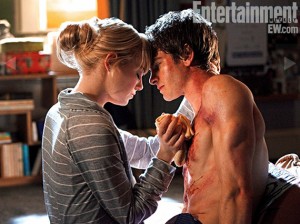The Amazing Spider-Man
Posted on July 2, 2012 at 8:00 pm
B+| Lowest Recommended Age: | Middle School |
| MPAA Rating: | Rated PG-13 for sequences of action and violence |
| Profanity: | Mild language |
| Alcohol/ Drugs: | Some social drinking |
| Violence/ Scariness: | Extended superhero fantasy peril and violence, some teen bullying, sad loss of four parents/parent figures, some disturbing mutation images |
| Diversity Issues: | None |
| Date Released to Theaters: | July 3, 2012 |
| Date Released to DVD: | November 5, 2012 |
| Amazon.com ASIN: | B008QZ5PY2 |
One thing I love about comics is that they are the only form of story-telling, with the possible exception of soap operas, where so many different people tell open-ended stories about the adventures of the same characters through a period that stretches over decades. The Wikipedia entry on Spider-Man’s “multiverse” includes more than 30 different versions, from the comic strip, cartoon, mutant, and zombie to the spectacular, amazing, noir, hulk, and kid-friendly “Spider-Man Loves Mary Jane.” So, much as I enjoyed the Tobey Maguire trilogy (well, the first two) directed by Sam Raimi, I was looking forward to this reboot.
It does not bother me that 28-year-old Andrew Garfield, who has already played a college student (“The Social Network”) and an adult (“Red Riding”) is playing a high school student. It does not bother me that we have to go through the whole origin story all over again — spider bite, having fun trying out the new powers, death of kindly Uncle Ben (Martin Sheen taking over from Cliff Robertson), though it really should not take up nearly an hour, and much as I love her, Sally Field can’t match Rosemary Harris’ iconic Aunt May. The efforts to tie Peter Parker’s parents (briefly glimpsed Campbell Scott and Embeth Davidtz) in with the shenanigans going on at Oscorp feel cluttered, and Rhys Ifans as the scientist who lost an arm in his experiments and wants to find a way for humans to regrow limbs the way some animals do does not make a strong impression either as human or as the Godzilla-like creature he becomes. The problem may be that if Sony does not keep up its schedule of Spider-Man movies, the rights revert to Disney, which bought Marvel. So at times it feels like a place-holder for the franchise.
But there are a couple of things that work very well and make this an entertaining entry in the superhero canon. First, and let’s face it, this is what we want from Spider-Man movies, it is a blast to see your friendly neighborhood Spider-Man swing his webby way through the city. In crystal clear IMAX 3D and with true mechanical effects — that is Garfield’s real weight swinging on real strings, not CGI — it is exhilaratingly vertiginous.
Garfield is less soulful and broody than Maguire, more athletic and witty. Peter Parker’s hipster signifiers include a skateboard, a hoodie, and a Mark Gonzales poster. And the heavenly Emma Stone plays beautiful science nerd Gwen Stacey, a more interesting character than would-be actress Mary Jane. There is genuine electricity between Peter and Gwen and director Marc Webb brings the same feel for young love he displayed in “(500) Days of Summer.” This unexpected tenderness gives heft to the story that in its own way is exhilaratingly vertiginous, too, and gave my Spidey sense a bit of a tingle.
Parents should know that this film has extended super-hero action-style violence, not very graphic but with some disturbing images of mutation and peril, and four sad deaths of parents or parent figures.
Family discussion: How does this compare to the Tobey Maguire Spider-Man series? Why didn’t Peter try to stop the robbery when he first got his spider-powers? What made Connors and Chief Stacy change their minds about Spider-Man?
If you like this, try: the first and second of the Tobey Maguire “Spider-Man” films and the Essential Amazing Spider-Man by Stan Lee, Steve Ditko, and Jack Kirby
